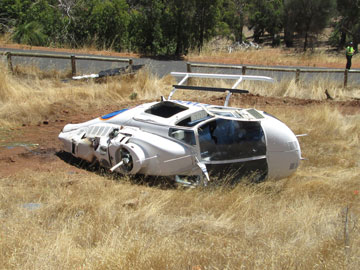
The ATSB is cautioning helicopter pilots about the dangers of ‘loss of tail rotor effectiveness’ following the forced landing and crash of a Bell 206B3 helicopter in Perth earlier this year.
The accident occurred on 19 January 2013, while the helicopter was being used on an aerial filming task over hilly terrain.
After hovering and manoeuvring at about 500 ft above the ground to allow the camera operator to record footage of a truck accident, the pilot conducted a final circuit to complete filming and depart the area. The pilot began the turn when the nose of the aircraft moved left, then suddenly and rapidly to the right as the helicopter yawed and quickly rotated five times.
The pilot regained some control close to the ground, but judged that a forced landing was inevitable. In an area with a number of obstacles, the pilot selected a clearing and managed to perform a low-impact landing. The slope that he landed on, however, resulted in the helicopter immediately rolling over with the engine still operating. Fortunately, it did not catch fire, a factor that can make all the difference for the survival of occupants in such accidents.
As well as understanding how LTE can occur, pilots should be familiar with the recommended recovery techniques and apply them immediately to the fullest extent possible in the situation.
The ATSB investigation found that when the pilot turned to the right to commence the circuit, the helicopter was exposed to a crosswind from the left while operating at an airspeed that left it susceptible to loss of tail rotor effectiveness (LTE) — a phenomenon which can send a helicopter moving in unexpected directions while temporarily robbing the pilot of control.
Aerial photography from most helicopters at relatively low airspeed and height, over hilly terrain in variable winds, is a challenging task with an inherent risk of LTE. In those circumstances, where visual cues can be misleading, pilot attention to airspeed, height and orientation to local wind is critically important. And, as in this occurrence, LTE can be preceded by momentary strong yaw in the opposite direction—a characteristic which is counter-intuitive and has the potential to be confusing for the pilot. There are recommended techniques for recovering from LTE.
The helicopter operator advised that as a result of the accident they conducted an internal investigation and implemented a number of safety actions in relation to LTE training and aerial work guidelines.
Read the report: Loss of control and forced landing involving Bell 206B3 helicopter, VH-ZMN, 18 km north-east of Perth Airport, Western Australia, on 19 January 2013


